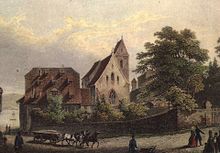St. Alban's Monastery (Basel)
The monastery of St. Alban in St. Alban-Tal was the first monastery in Basel , an older monastic community only formed the cathedral chapter of the cathedral . The foundation of the monastery in 1083 was initiated by the then Basel Bishop Burkhard von Fenis , who made it subject to the Benedictine rule. Church and monastery buildings were built shortly afterwards at the turn of the 12th century. However, the earliest signs of construction go back to the 8th / 9th. Century back. The monastery was dedicated to Our Lady, Christ and the martyr Alban of Mainz or Alban of England , who was venerated in Basel since 855; but it is not clear which of the two saints with this name it is. The monastery church was rebuilt around 1270, and so was the monastery, which was almost completely destroyed by the earthquake after 1356 . Renovations, extensions and new constructions were carried out several times, especially after the fire of 1417. After considering a complete demolition, the church was heavily redimensioned in 1845 (demolition of part of the nave and an entire aisle). Parts of the monastery had already been demolished in 1838. In 1890, 1911 and 1979 extensive restoration work was carried out on the church, the monastery was completely rebuilt for residential purposes in 1876 and 1914, and renovated in 1934 and 1979/1992.
St. Alban with its originally twelve monks was a Cluniac priory from 1093 , i.e. a monastery with a prior as head, appointed by the abbot of the main monastery of Cluny. Like all of Cluny's other clientele monasteries, St. Alban enjoyed many legal privileges over other secular and spiritual lords. It had extensive land holdings inside and outside the city (including Lörrach ), exercised the lower jurisdiction there and received considerable benefices, but hardly appeared in the political and intellectual life of the city. The duties of reporting to the monastery parishes took people's priest true, not monks. The monastery was mainly active in nursing and operated a pilgrims' hostel and an infirmary from 1278 at the latest, which were not rebuilt after the fire of 1417. It is possible that the monastery also operated an infirmary . The monastery fell into disrepair in the second half of the 15th century and lost its privileges as a Cluniac priory, and the city took over jurisdiction.
After the Reformation of 1529 the monastery was abolished and taken over into municipal ownership, but in 1532 the city council reaffirmed the last prior of St. Alban. Only early masses took place in the church. From 1537 to 1694 the monastery served as a Schaffnei , from 1693 to 1835 it was leased (a cholera hospital was set up for a short time in 1832 ), and in 1840 it was sold to the Freyvogel & Böcklin tape factory ; the painter Arnold Böcklin spent part of his youth here. In 1875 the St. Albanstift Foundation , which is still active today , moved in to create affordable housing (originally for pastors and teachers' widows).
The St. Alban's Church is still actively used today.
literature
- René Teuteberg : The St. Alban's Monastery and the suburban society of the high Dolder , Basel 1992
- Ester Baur Sarasin: St. Alban Valley in Basel . Society for Swiss Art History, Bern 1992, ISBN 3-85782-529-4
- Pascal Ladner : The St. Albank Monastery in Basel and the Burgundian tradition in the Cluniac province of Alemannia, Basel 1960 (Diss .; Basel contributions to historical science, vol. 80)
- Florian Lamke: Cluniacensians on the Upper Rhine. Conflict resolution and noble group formation during the investiture controversy, Freiburg / Munich 2010, esp. Pp. 273–365.
Web links
- Picture of the St. Alban pen around 1841
- Veronika Feller-Vest: Sankt Alban. In: Historical Lexicon of Switzerland .
Coordinates: 47 ° 33 '16.5 " N , 7 ° 36' 1.8" E ; CH1903: 612 185 / two hundred and sixty-seven thousand one hundred and ten

